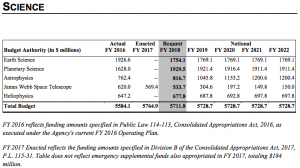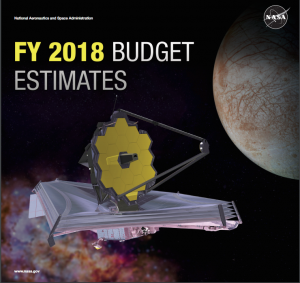May 31, 2017
NASA Fares Okay in President’s FY18 Budget Request
Posted by bwebster
Relative to other federal science agencies, NASA fares fairly well in the president’s budget request, receiving an overall 3% cut in funding from FY17 funding levels.
The President’s budget breaks with Obama era policy by officially terminating the Asteroid Redirect Mission (ARM). ARM was very unpopular with Congress, but continues many of the key technologies in development for the mission, such as solar electric propulsion.
SMD Recieves .94% Cut
The President’s budget proposes a less than one percent cut to the Science Mission Directorate (SMD), although that cut is felt disproportionably among with the mission areas. The President’s budget also initiates an SMD-wide CubeSats/SmallSats initiative on the basis of a recent National Academies study “that concluded that, due to recent technological progress in both private sector and through federal investments, these small satellites are suitable to address specific high-priority science goals.” The budget proposes allocating $70 a year for this initiative.
NASA’s Earth Science Mission received a substantial cut in the President’s budget, at 8.7% from the FY17 spending bill. To satisfy this decrease in funding, the budget calls for the termination of five Earth science missions, including: PACE, OCO-3, RBI, DSCOVR Earth-viewing instruments, and CLARREO Pathfinder. The budget does provide funding for Landsat 9 and the accelerated FY 2021 launch as well as ICESat-2, the radar portion of DESDynI, GRACE-FO, and SWOT. The budget also supports ongoing work on 14 current missions in formulation and development, and the routine selections of new Venture Class projects.
Planetary Science received the only increase in funding within the SMD, with a 4.5% increase from FY17 funding levels. The President’s budget provides full funding for a Jupiter flyby mission, the 2018 launch of InSight, the Mars 2020 Mission, and the Discovery Asteroid missions, Lucy and Psyche. Significantly, the budget does not provide funding for a Jupiter lander, which has been a priority for House COmmerce-Justice-Science Appropriations Subcommittee Chairman John Culberson (R-TX-7). The budget also proposes to increase research and analysis (R&A) spending by 5 percent above the FY 2011 budget level, and then 1.5 percent above inflation thereafter. The total R&A budget in FY 2011 was $208 million. This budget funds R&A programs at $229 million in FY 2018.
 The James Webb Space Telescope received a planned decrease in funding in preparation for its launch in 2018.
The James Webb Space Telescope received a planned decrease in funding in preparation for its launch in 2018.
The budget proposes a .1% decrease in funding for Heliophysics. The budget proposes $381 million in funding for the Living With a Star (LWS) program to enhance our ability to forecast and characterize space weather events in collaboration with NASA’s inter-agency partners. The budget provides full funding for the Solar Probe Plus and the Solar Orbiter Collaboration. The president’s request provides funding for the implementation of the Diversify, Realize, Integrate, Venture and Educate (DRIVE) Initiative as recommended in the Heliophysics Decadal Survey, and includes an increase for the Cubesats small satellite project. This budget also supports the launch of Ionospheric Connections Explorer (ICON) and Global-scale Observations of the Limb and Disk (GOLD) in 2017 and 2018 respectively.
NASA’s Office of Education
The budget also proposes the elimination of the Office of Education, with the proposed funding being used to phase out the office by 2019. The president’s budget proposes closing this office because of the challenges the office faced implementing a NASA-wide education strategy given the financial constraints. The Office currently oversees over 200 federal grants and cooperative agreements and major programs include: Space Grant, EPSCor, and MUREP.
NASA’s budget states that “NASA will continue to inspire the next generation through its missions and the many ways that our work excites and encourages discovery by learners and educators.” Additionally, the STEM Science Activation program within the SMD will continue. The proposal to phase out the office is likely to receive strong pushback from Congress, who appropriated $100 million for the office earlier this month.
For more, see the NASA budget highlights and full budget request here.
Concerned about these cuts? You can do something right now. The President’s budget is just a suggestion, Congress has the ultimate say in how our government is funded. Take 5 minutes and speak up for the National Aeronautics and Space Administration by sharing with your legislators why this agency is critical to America’s scientific enterprise.


